How to Conduct a TikTok Competitor Analysis: Key Steps and Strategies
Learn how to run a complete TikTok competitor analysis - from uncovering trends and tracking key metrics to optimizing your strategy for growth.
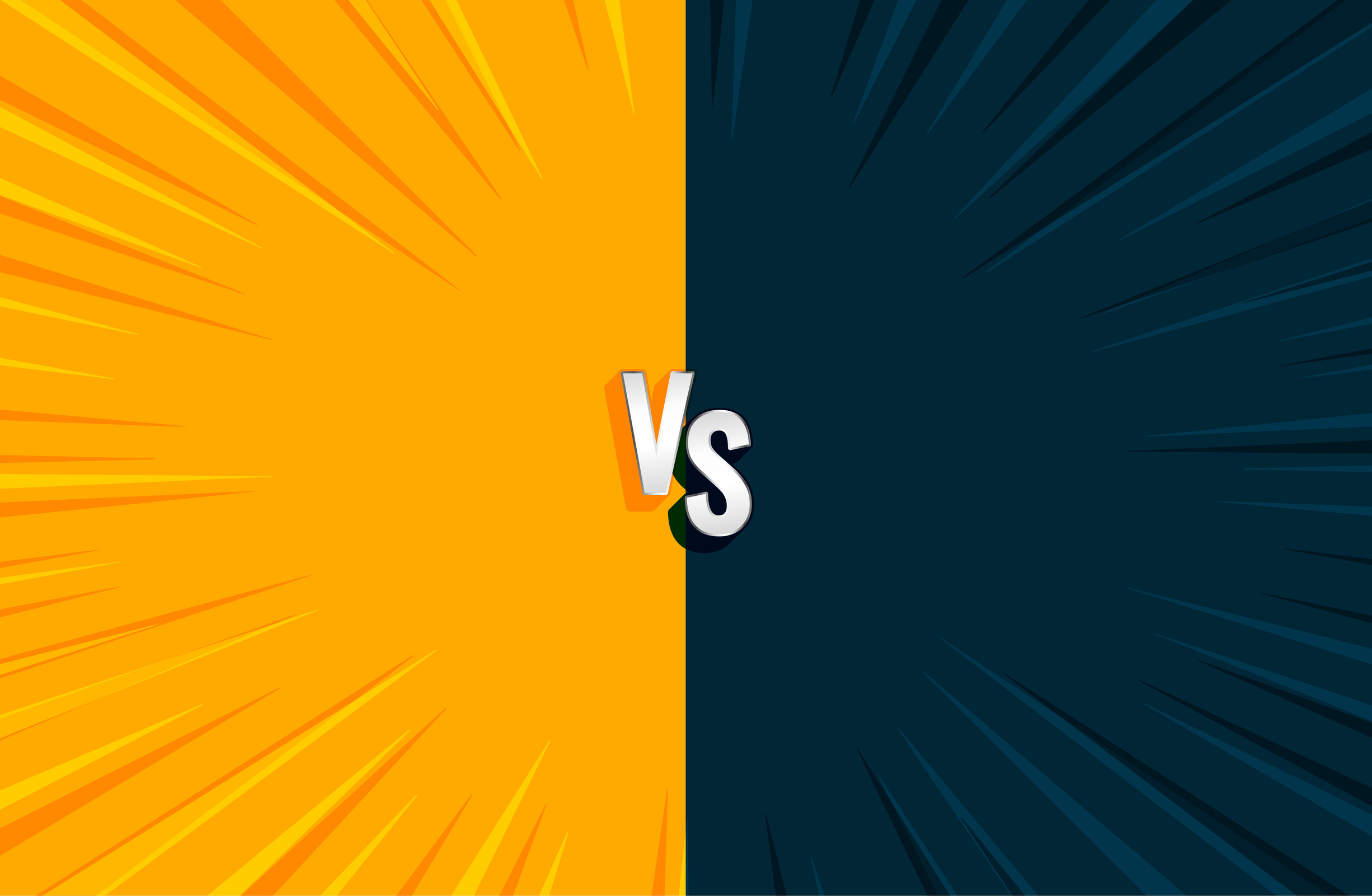
When I first started doing TikTok competitor analysis, I’ll be honest, I was all over the place. I pulled every number I could find, but didn’t know how to turn TikTok analytics into something useful.
I figured it out with experimentation and learning from the right people in the field. I learned how to cut through the clutter, focus on the right signals, and piece together a clear picture of why competitor content worked or failed.
That shift completely changed the way I build my own TikTok strategy.
In this guide, I’ll walk you through the exact process I use for competitor analysis. It’s the same framework many brands follow, and you can replicate it to make your TikTok strategy sharper and more effective.
Key takeaways
-
Identify direct, indirect, and aspirational competitors to get a full market view
-
Track growth (followers, views) to measure reach and momentum
-
Focus on engagement metrics (comments, shares, saves) over vanity metrics
-
Analyze content pillars, audio usage, editing style, and posting cadence
-
Benchmark your performance against competitors to spot strengths/weaknesses
-
Study both top-performing and failed competitor posts for complete insights
-
Monitor trends early to ride momentum before they peak
-
Look at audience sentiment in comments to uncover deeper insights
-
Identify micro-communities competitors attract and tailor content for them
-
Translate findings into action: fill content gaps, replicate success with your own twist, and prioritize what drives ROI
-
Avoid blindly copying competitors—adapt strategies to fit your brand voice
-
Run competitor analysis quarterly to stay aligned with TikTok’s fast-changing trends
What is a TikTok competitor analysis?
A TikTok competitor analysis involves identifying competitors and evaluating their performance, content, and audience engagement to spot strengths, weaknesses, and gaps.
The goal is to understand:
- What kind of content they post: formats, trends, themes, and storytelling styles.
- How their audience responds: engagement rates, shares, comments, duets, and sentiment.
- Which strategies drive growth: posting frequency, hashtag usage, use of trending sounds, influencer collaborations, or seasonal campaigns.
Want to check out how you stand against your TikTok competitor? Try out our free head-to-head TikTok comparison tool.
Why run a TikTok competitor analysis?
Still wondering if a TikTok competitor analysis is worth the effort? Here are four reasons that will make you go, “I definitely need to invest in a TikTok competitive analysis.”
Identify content gaps and opportunities
Creative ruts happen. You can only come up with so many fresh TikTok ideas before things start feeling recycled. That’s where competitor scrolling pays off.
You’ll see the content pillars they are using, the storytelling techniques they are riding on, and the kind of CTAs working for them. But more importantly, this will let you know what they are failing to capitalize on.
Maybe everyone’s showing off products, but no one’s telling customer stories. That gap is your opening to step in, own it, and win attention they’re leaving on the table.
Benchmark performance and see where you stand
Without context, your numbers mean very little. Competitor benchmarks show whether your engagement rate, follower growth, or posting frequency is above average or lagging behind.
For example, your videos may be getting more views. But is it showing greater engagement compared to your competitors? This is how you can know whether your content is actually hitting the mark.
Track trends before they die
Trends move fast on TikTok, and late adoption can make your brand feel outdated. Watching competitors helps you see which sounds, challenges, or creative styles are gaining traction early.
If you spot a recurring format across multiple competitor accounts, it is a strong signal to test it quickly. The faster you act, the higher the chances of riding the trend’s momentum before it peaks and loses novelty.
Uncover micro-communities you have missed
Competitors often build unexpected traction with niche groups you may have overlooked. Maybe a rival brand is getting consistent engagement from sustainability advocates because they highlight EVs and eco-friendly features.
By analyzing who engages most with competitor posts, you can uncover these micro-communities and create tailored content that turns overlooked niches into loyal fans.
Essential TikTok competitor metrics you need to track
TikTok growth metrics
TikTok growth metrics track how fast and far your competitor’s presence expands on the platform, showing whether their content reaches new audiences.
- Views: Views show how many times their videos are watched. It helps you gauge visibility, spot content that creates huge upticks, and identify formats worth doubling down on.
I usually track the views distribution over time on Socialinsider to see the sharp upticks and dips, and what content led to that.
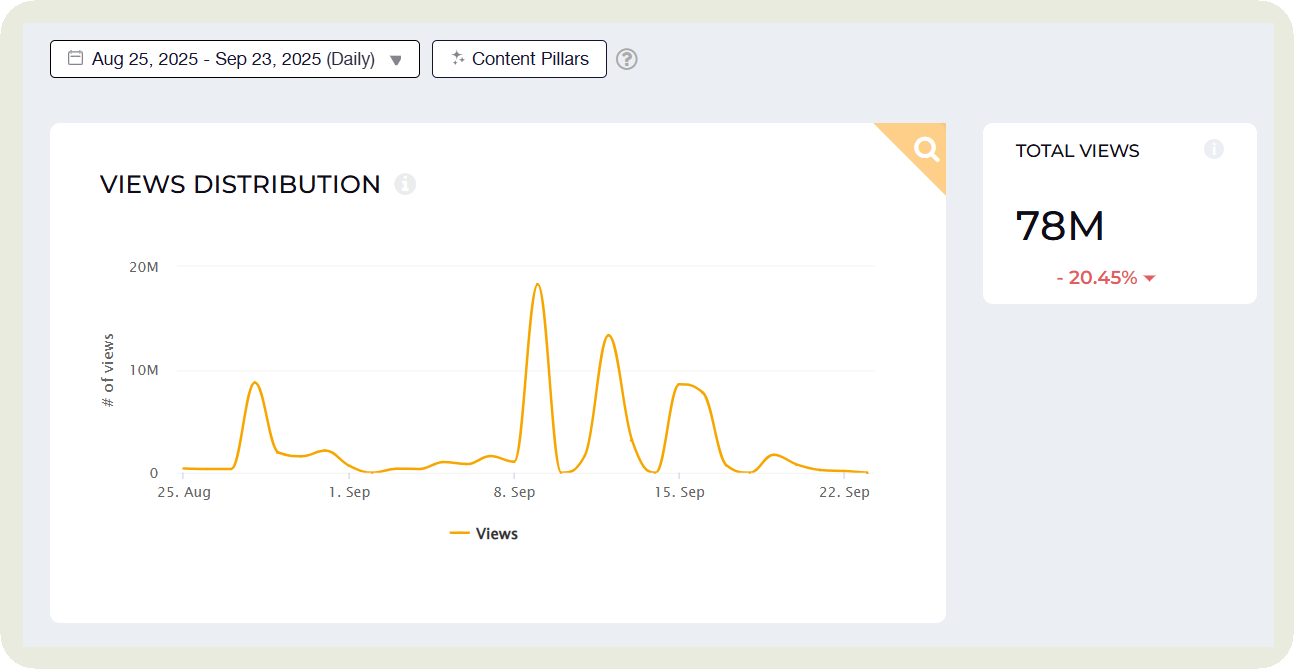
- Follower growth: This TikTok follower analytics tracks how quickly your competitor’s audience expands over time. Monitoring growth shows whether their content is attracting new audiences, building loyalty, and sustaining momentum.
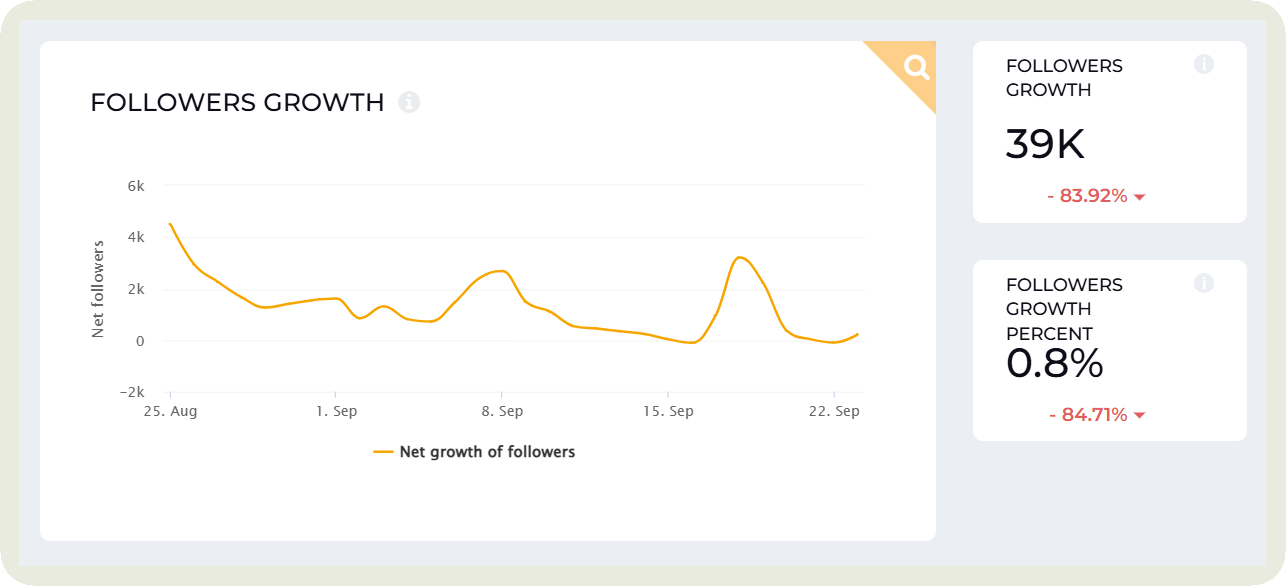
TikTok engagement metrics
TikTok engagement metrics show how audiences interact with your competitor’s content. Tracking them helps you understand what sparks real connection versus passive views.
- Average engagement rate by views: This measures how many interactions (likes, comments, shares) a video generates compared to its total views. It reveals which content truly resonates with your competitor’s audience.
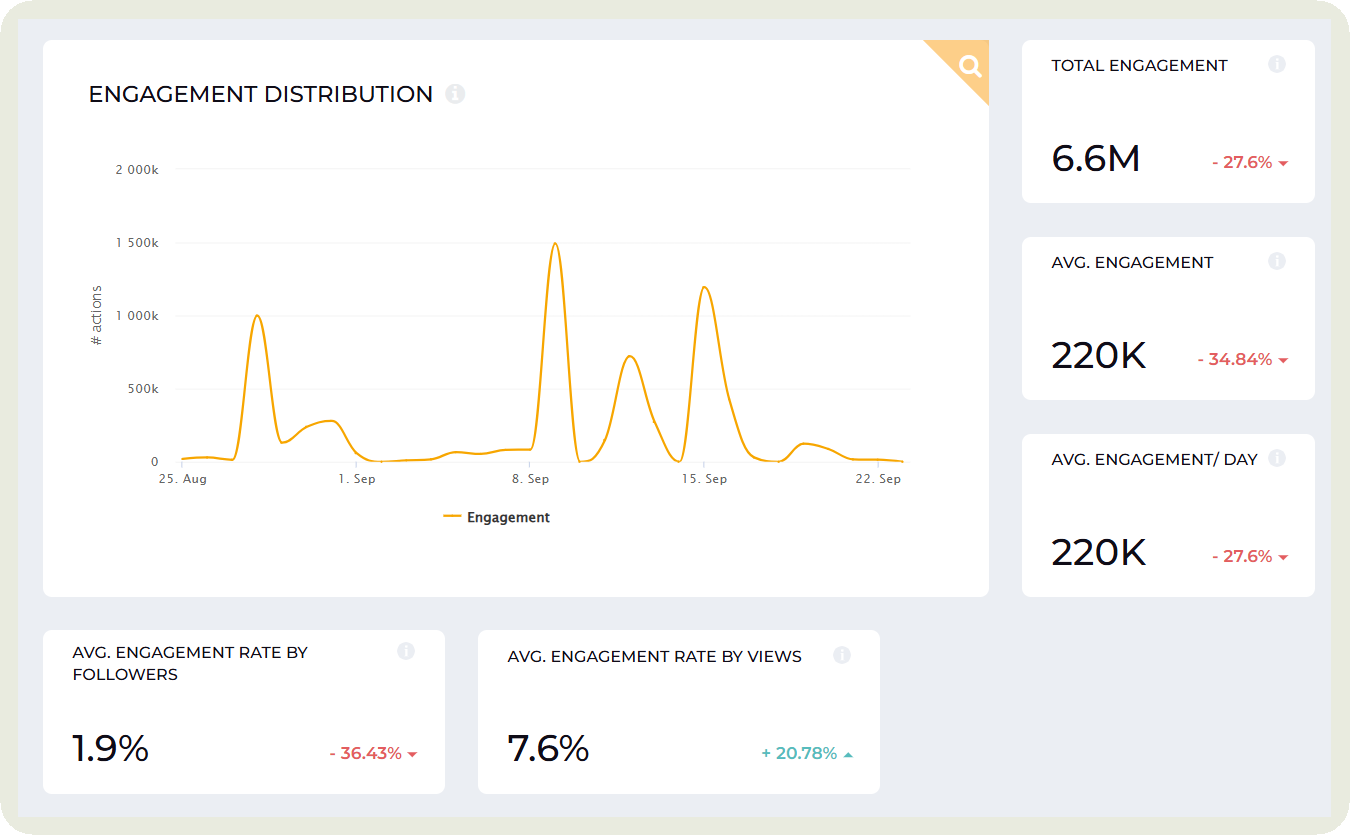
- Total engagement: This sums up all interactions on your competitor’s content, including likes, comments, shares, and saves.
- Likes and comments: They reflect how audiences respond to their content, with likes showing quick approval and comments signaling deeper interest or conversation.
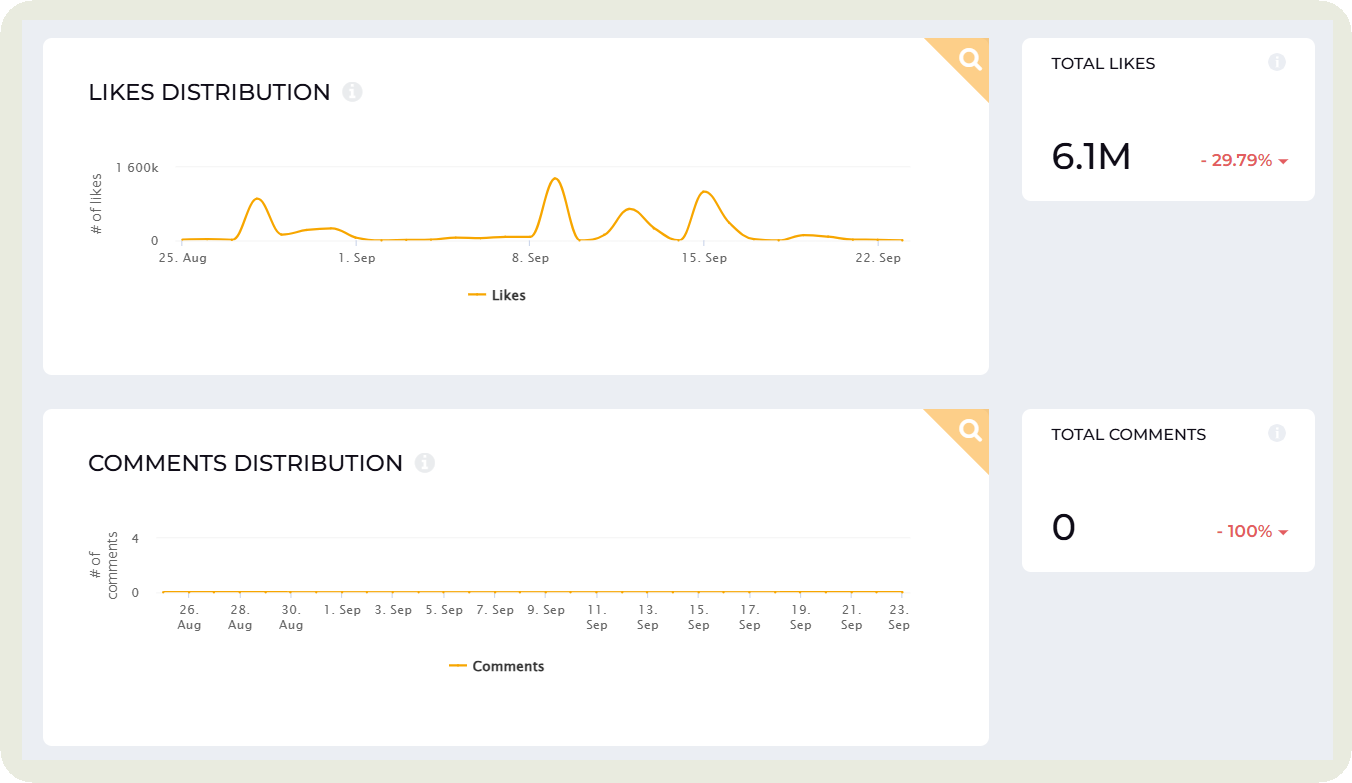
- Shares and saves: They indicate high-value engagement, showing that viewers find your competitor’s content worth spreading or revisiting later. This indicates whether competitors are creating valuable content.
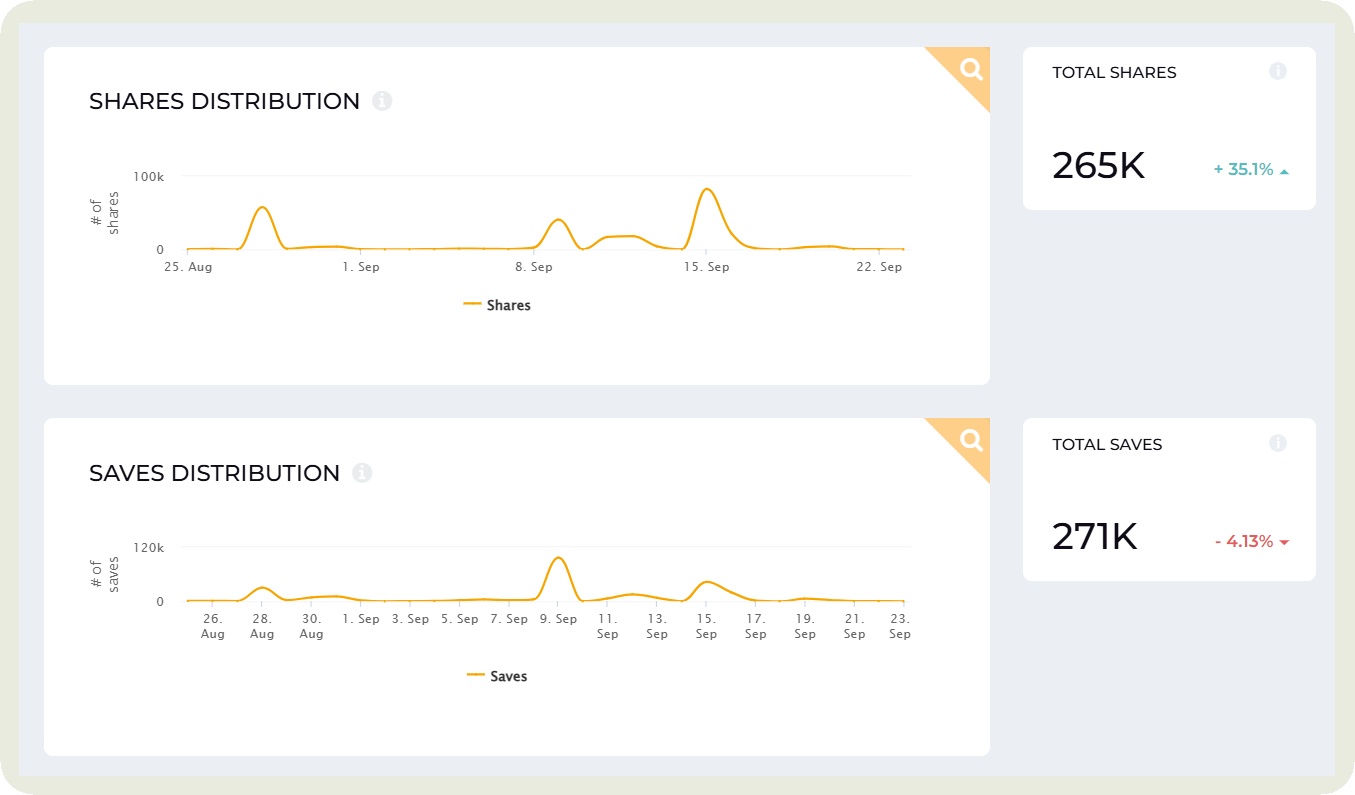
Sam Gillies, chief content officer at Nonsensical, a TikTok marketing agency, talks about looking beyond vanity metrics and considering other metrics while running a competitive analysis.
He says, “Too often, brands get stuck on vanity metrics. Followers fall into that category. They’re nice to have, and everyone likes them, but they’re much harder to grow now than they were in TikTok’s early days (Think 2020-2022).
The real focus should be on views and bottom-up engagement: shares and saves. Those are the metrics that truly matter.”
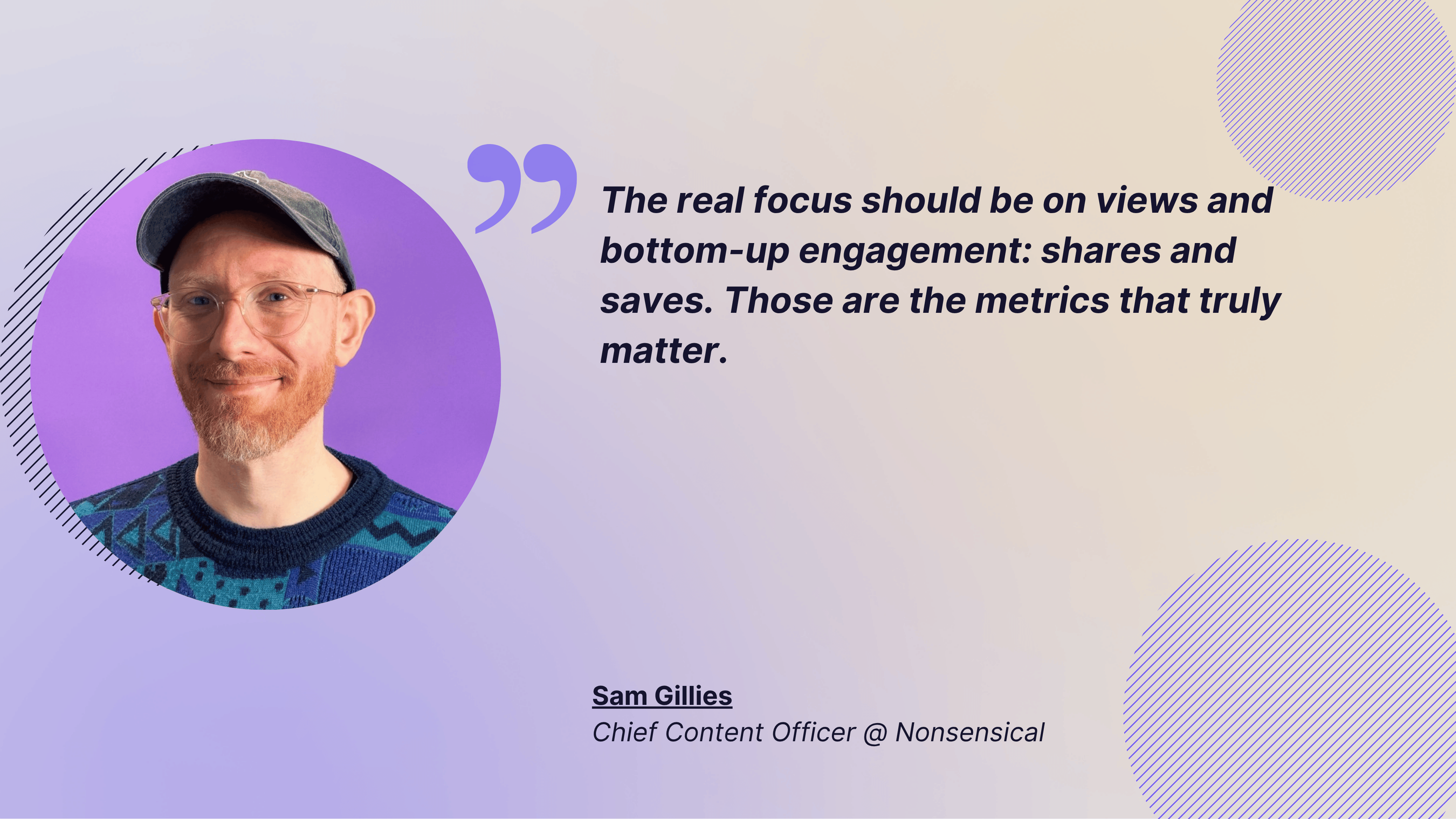
TikTok content performance metrics
TikTok performance analytics for content show how well each post resonates, helping you track what drives engagement and optimize creative strategies.
- Top-performing content pillars: Shows you the content categories that generate the highest engagement for your competitors. It helps you find content themes you may not have explored yet or doubled down on.
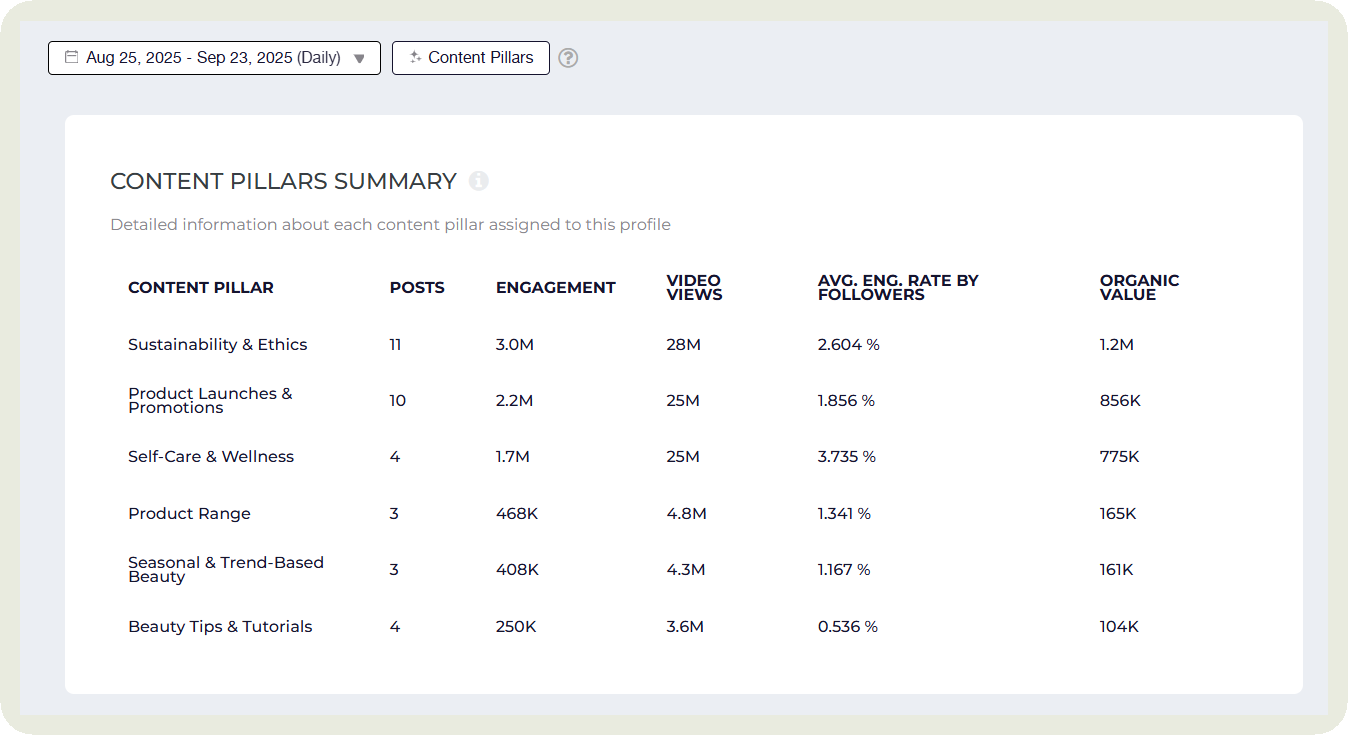
- Optimal posting time according to engagement: Tracking this shows when competitors get the most TikTok engagement. You can identify peak activity windows and experiment with these timings to maximize visibility and engagement for your TikTok strategy.
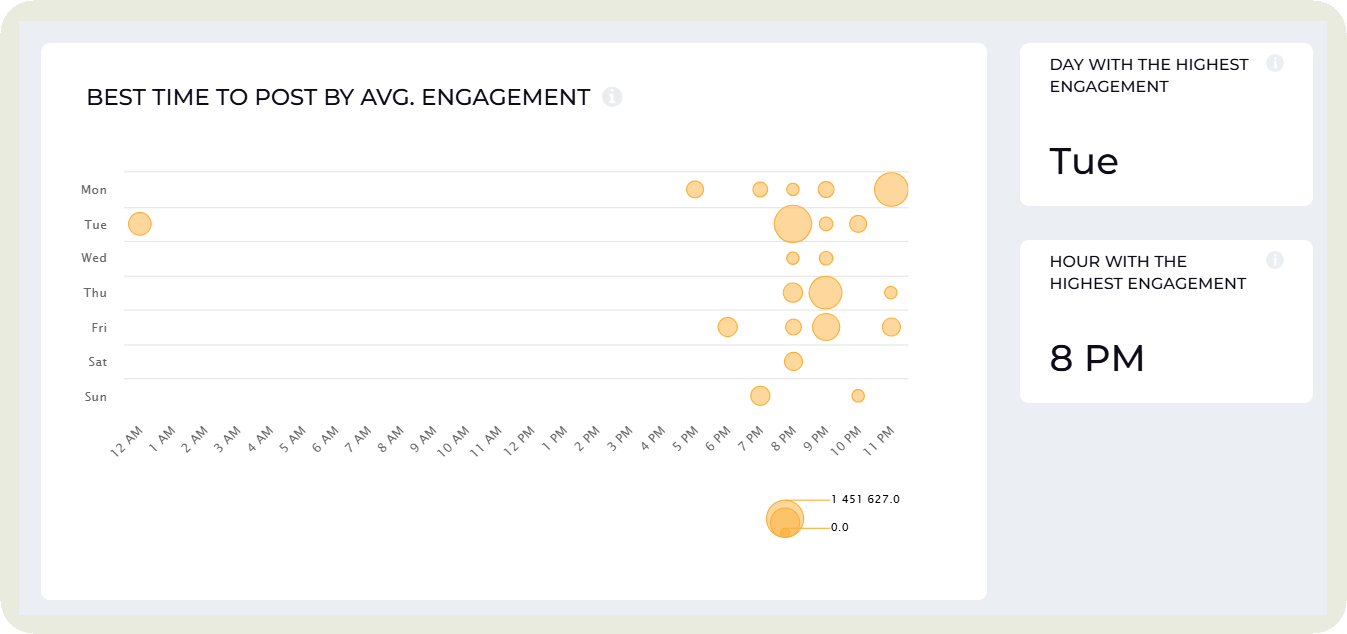
- Top and bottom performing content: Shows which competitor posts drive the most or least engagement. This reveals data on what resonates with their audience and helps you avoid formats that fall flat.
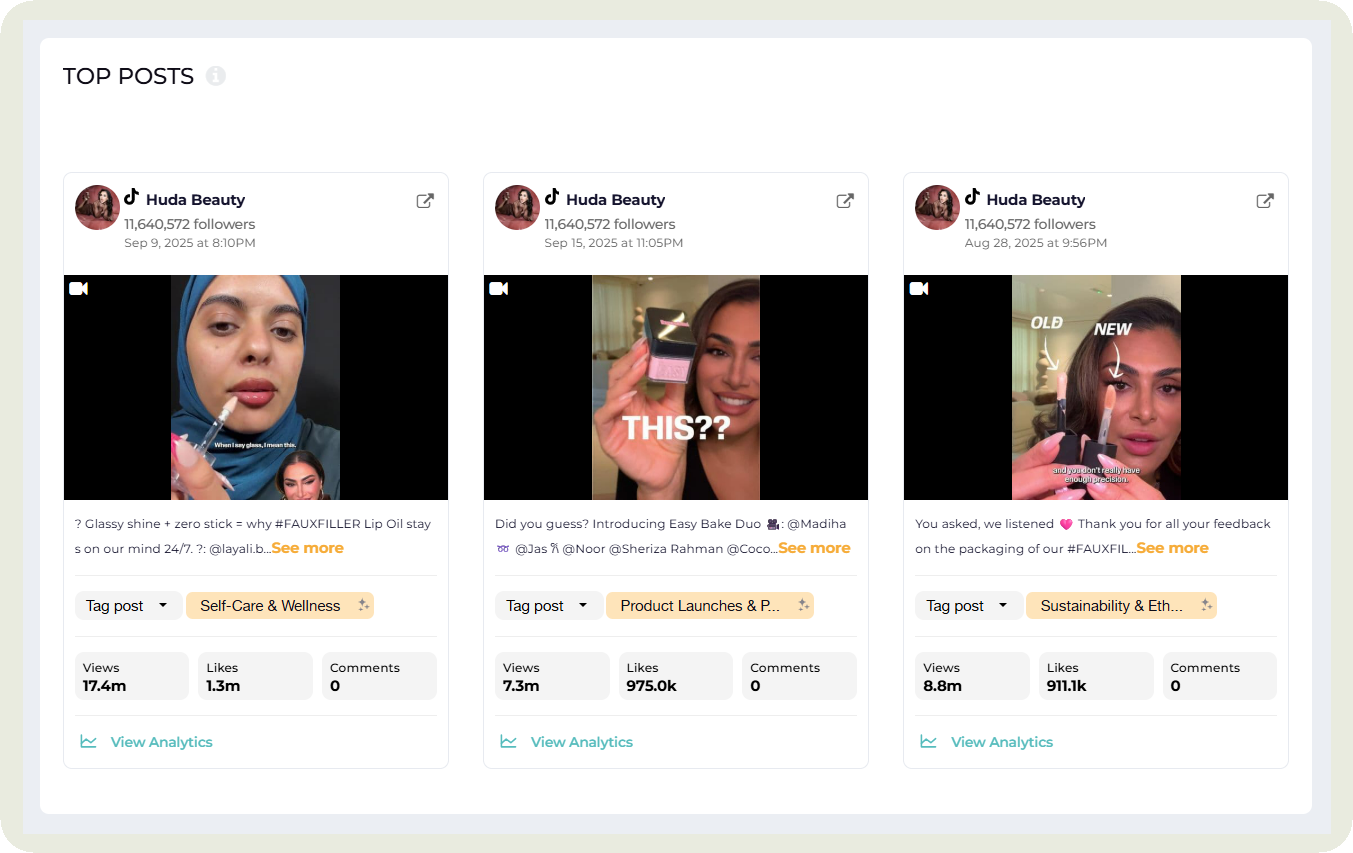
- Top hashtags by average engagement: Shows which hashtags competitors use that consistently drive interactions. It helps you spot trending or niche hashtags worth testing.
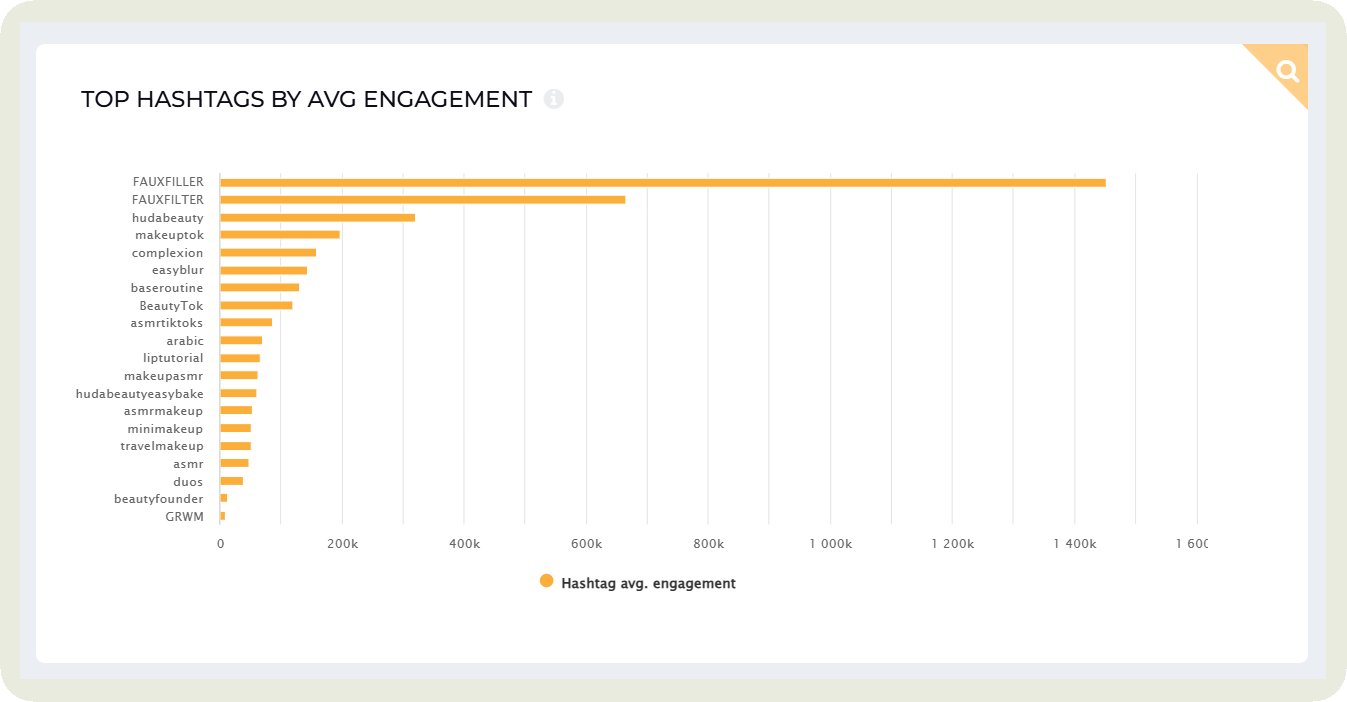
- Trending audio usage effectiveness: Measures how well competitors leverage popular sounds to boost engagement and reach. Tracking it helps you see which audios spark the most views or interactions, revealing trends worth adapting.
- Posting cadence and frequency: How often do they post videos? What is the frequency of each of their content pillars? This gives you an overall idea of what works for them and if you need to experiment with your posting strategy.
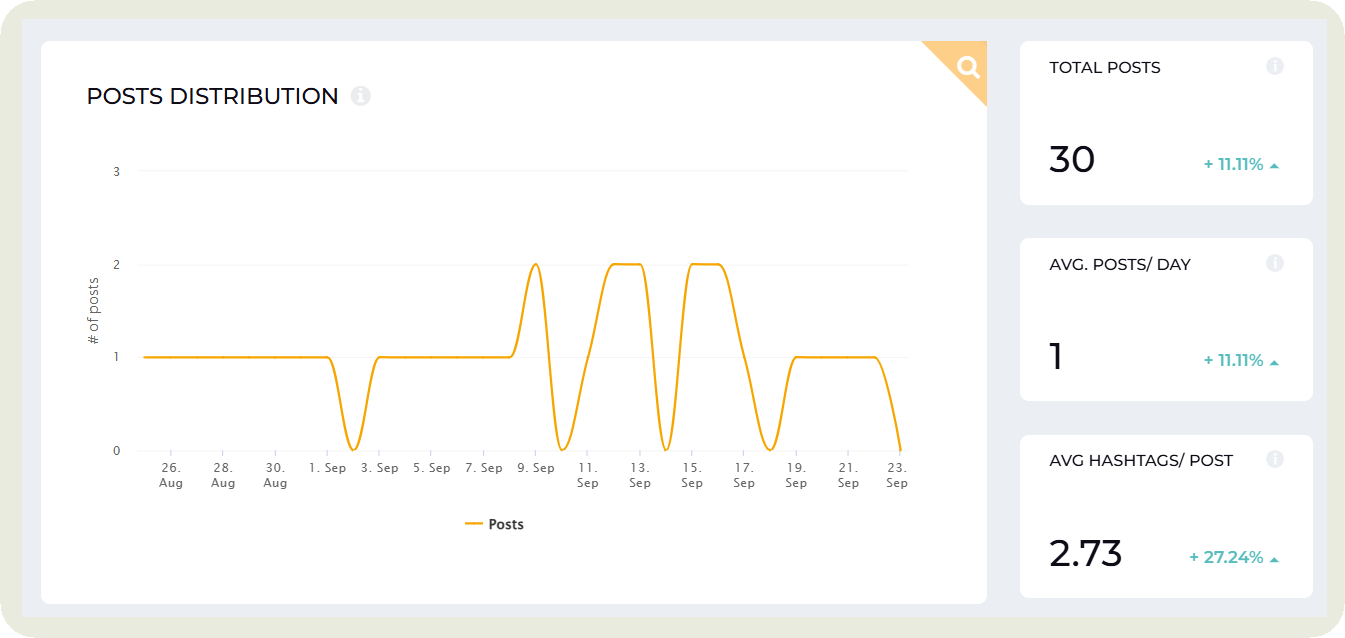
While talking to Sam, he mentioned looking at posting frequency while conducting this analysis —
We’d start from their top metrics: what’s their organic video views each month and associated engagement against it. Alongside that, we’d give it more of a ‘sniff’ test in terms of how the account looks, are they posting frequently. Does it feel ‘unique’ in any way, or is just a collection of videos without much purpose?
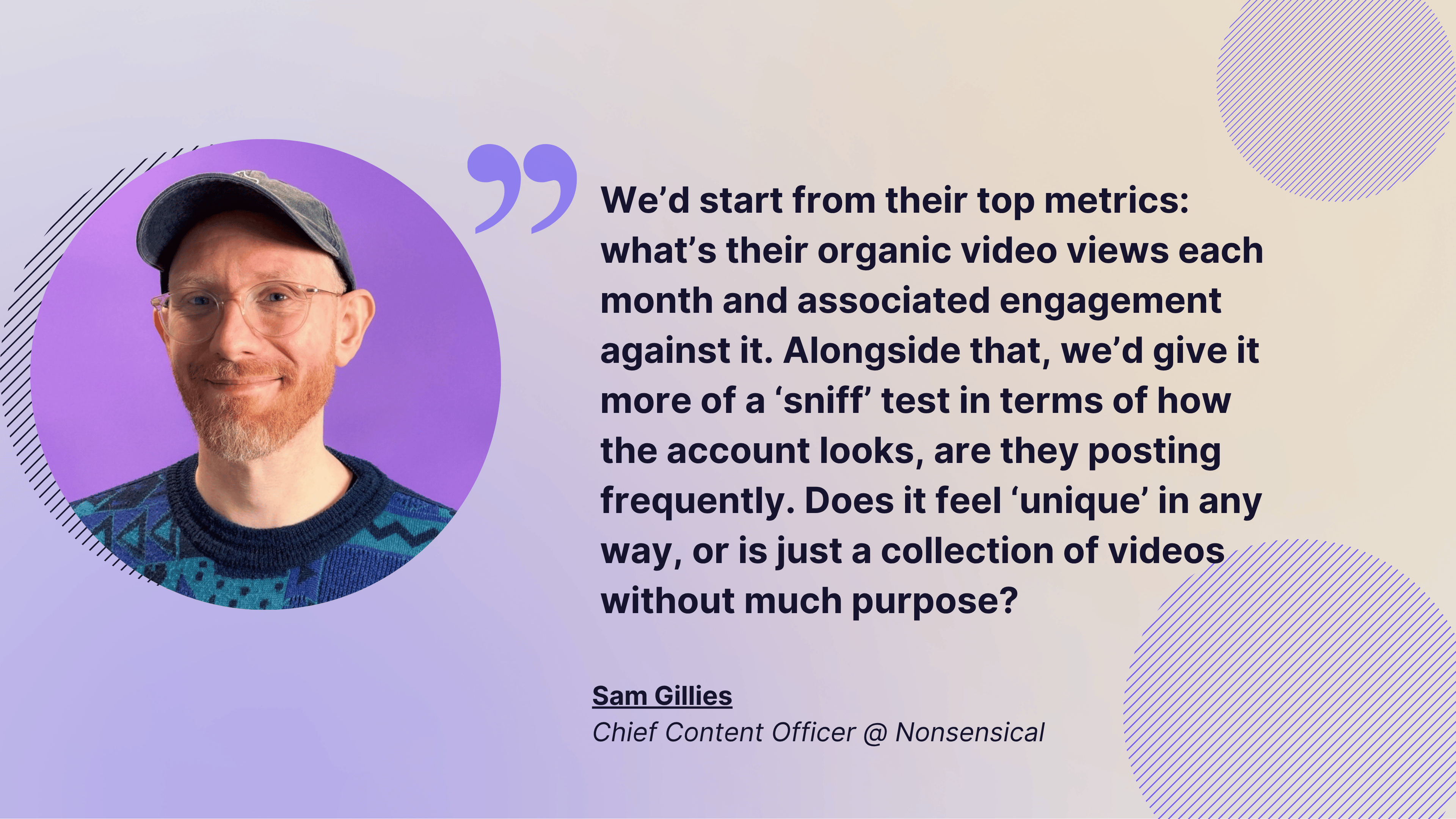
How to conduct a TikTok competitor analysis in 5 steps
A clear process for TikTok competitor analysis makes it easier to uncover insights and share them with your team in a way that drives action. Here’s the step-by-step approach I use.
Step 1: Identify and shortlist competitors
I group competitors in three different categories for easy identification and vetting.
- Direct competitors: These are the brands fighting for the same audience with a similar product. For this process, we’ll consider BMW. On TikTok, BMW’s direct competitor is Mercedes-Benz. Both want to own the luxury car conversation.
- Indirect competitors: These players don’t sell the same thing but still compete for attention. For BMW, Volkswagen fits here. It’s not luxury-first, but it wins engagement with humor, trends, and relatability. Studying indirect competitors shows you how different angles can steal your audience’s screen time.
- Aspirational competitors: These are brands outside your niche whose content you admire and want to learn from. BMW might look at Nike or Apple. Not car companies, but masters at storytelling and community building. Aspirational competitors push you to level up creative strategy, not just product marketing.
But how do you find these competitors in the first place? Here are five methods you can try.
- Hashtag analysis: Search hashtags your audience uses and see which brands dominate. Look up #ElectricVehicles or #CarTok and you’ll quickly spot who’s shaping the conversation. If I see a competitor name consistently showing up under high-engagement hashtags, I include them in my preliminary list.
For example, I did a keyword search on TikTok and found three company names consistently pop up: Mercedes-Benz, Tesla, and Porsche. Upon further vetting, you can shortlist the most relevant ones.
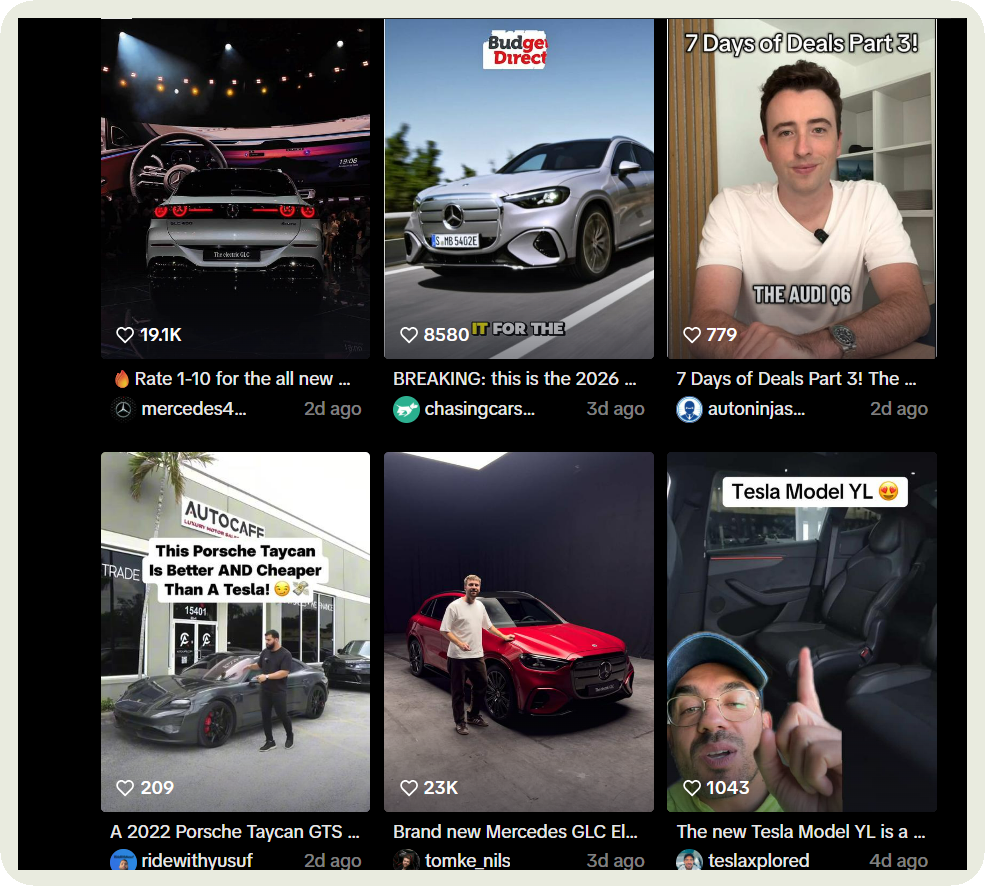
- Utilize search engines and cross-platform search: Find the keywords that brands in your niche use. Enter them on Google or platforms like Instagram to find companies that might fit your bill. Then, search for those accounts on TikTok.
- Utilize social listening: Use tools to monitor conversations around keywords, products, or industry themes. Maybe people aren’t tagging your competitors directly, but they’re raving about ‘luxury EVs’ and a competitor keeps popping up. Social listening helps uncover those hidden rivals you’d miss with manual searches.
Step 2: Analyze content strategy
If TikTok competitor analysis had a sweet spot, it’s content strategy.
But just looking at their posts means just touching the surface. The real insights come from pulling apart the choices behind them. Here’s how I do that.
Study the top-performing content for each content pillar.
I shortlist relevant content pillars for my brand and then hop on to Socialinsider to study each one. The best posts of competitors in each pillar show me three things: how they approach it, what the audience likes best, and any elements like CTAs or audio I might be overlooking.
The content pillars feature in Socialinsider lend me a helping hand. For example, I can see that BMW’s content ranks at the top for the content pillar — vehicle showcase and review. But it’s Volkswagen’s content that gets the highest engagement rate.
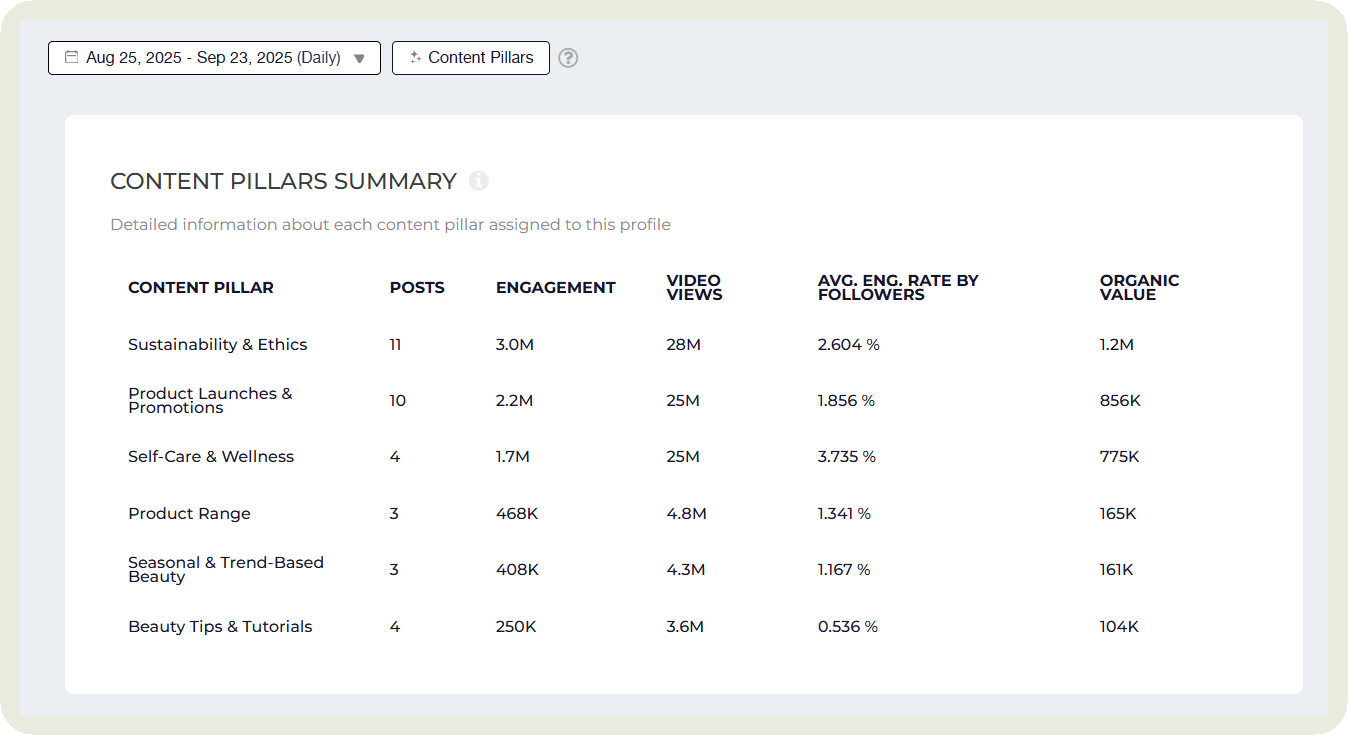
Upon deeper analysis, one reason came out strongly: Volkswagen adds the WOW factor that BMW misses out on. Their storytelling flows better, transitions are sharper, and suspense keeps viewers hooked.
Examine creative elements
Whether it’s content pillars or a wide array of TikTok features, there’s a lot to play with. Here’s what to look out for when performing TikTok competitor research for content.
- Content pillars: Which themes (product showcase, luxury lifestyle, humour, innovation, sustainability) do you find common in each competitor? Are there themes that come out on top for each? Are you prioritizing those content themes or are there any gaps that you should be capitalizing?
- Video length and editing style: Do shorter, snappier clips perform better, or do audiences stay for longer storytelling? Do competitors lean on fast cuts, trending transitions, or cinematic pacing? These TikTok video analytics will give you insights into what keeps users engaged.
- Audio usage: Are they tapping into trending sounds, original audio, or branded tracks? Pay attention to which type consistently drives higher engagement, since audio often determines whether content feels fresh, relatable, or instantly scrollable.
Upon looking at BMW’s most engaging content, I noticed they use trending sounds more than branded tracks.
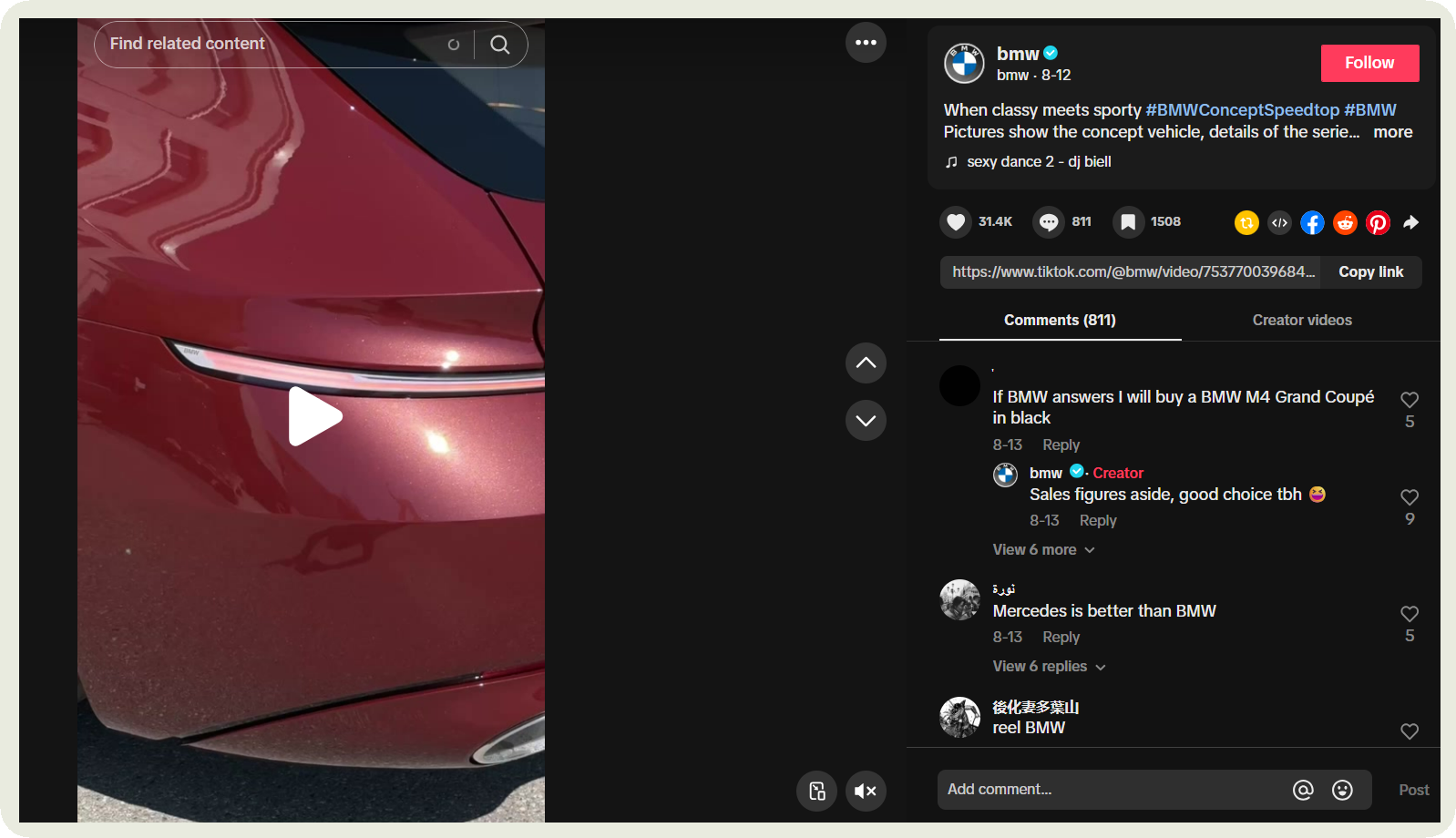
- Use of TikTok features: Check how competitors use duets, stitches, polls, or Q&A to drive interaction. This highlights features you can test to boost engagement.
Peek into their seasonal and trend-specific content playbook
Watch how fast competitors pick up new sounds, filters, or challenges. Do they spot trends early or jump in after they peak?
Also, look out for their seasonal campaigns and check if they lean on global moments like Earth Day or tailor content to local culture. For example, automobile companies may go product-heavy in particular seasons or months when buying is high.
Sort and analyze posts by key engagement metrics
Which of their posts brings the highest comments? Or the highest shares? This helps you understand what sparks conversation, what drives virality, and what type of content motivates audiences to take action beyond just watching.
For example, I use Socialinsider to sort posts by shares in order to understand the commonalities that make people hit the share button and how I can replicate that for my brand.
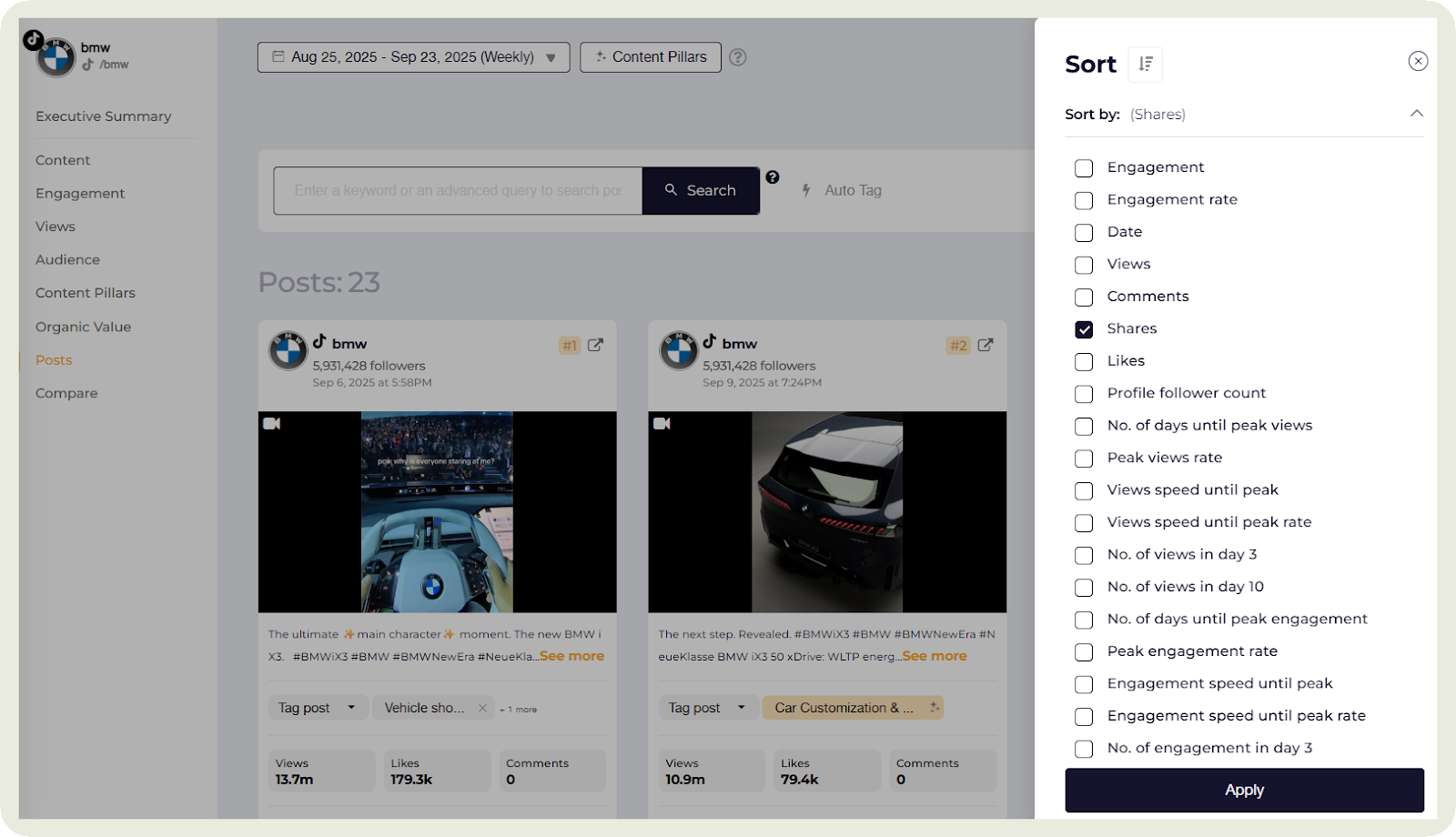
Check for posting frequency and consistency
See how often competitors post and whether they stick to a steady rhythm or drop content randomly. Spotting their cadence helps you set a posting pace that keeps your brand visible without burning out.
Step 3: Benchmark overall profile performance
Now that you know content-specific strategies, it’s time to analyze TikTok competitors’ overall account performance.
To do this, I use the TikTok competitive benchmarking feature on Socialinsider.
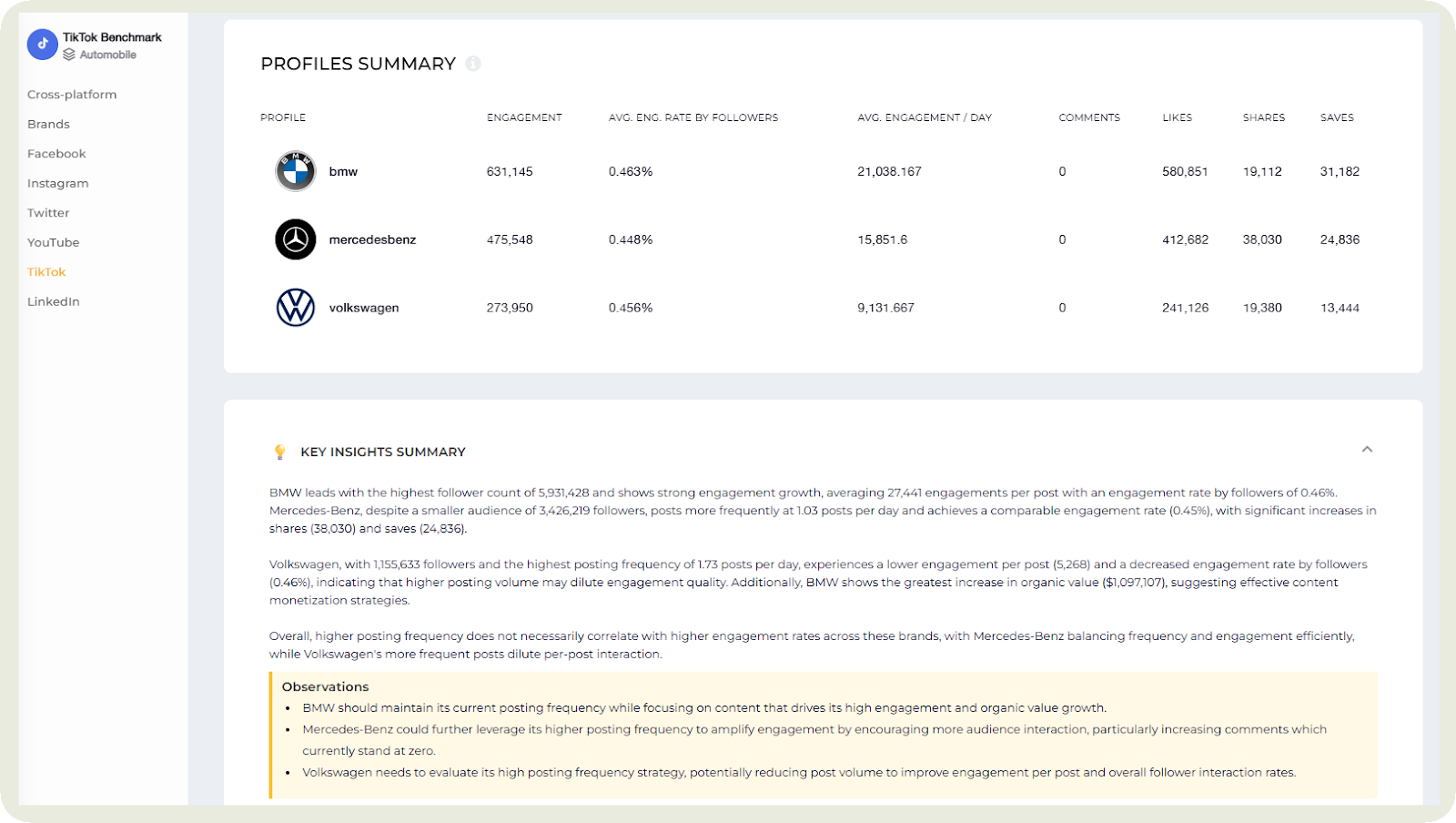
It shows me a quick run-through of important KPIs, and I love the Key insights summary that gives me an overall comparison of what the data reveals for that specific period.
Here’s how you can use it.
- Set up your project: Start by creating a dedicated project in Socialinsider so all your TikTok competitor data is organized in one place.
- Add profiles: Connect your own TikTok account and add the competitor profiles you want to track for side-by-side comparison.
- Get benchmarks: Head to the Benchmark section in the sidebar, select TikTok, and Socialinsider will generate performance benchmarks across the chosen accounts.
- Choose your key metrics: Use the drawer menu to select the TikTok metrics that matter most, such as engagement rate, follower growth, or posts/day, to tailor the analysis to your goals.
I also combine metrics and compare them with each other to get a better idea. For example, I compare posting frequency with engagement rate — do more frequent posts actually lead to higher engagement, or is quality winning over quantity?
Find out the combination that gives you the best insights and analyze them while benchmarking.
Step 4: Evaluate audience engagement and sentiment
All the steps above focus on numbers, showing how you stack up against competitors on hard TikTok analytics. But numbers only tell half the story.
Brands often skip the softer side of analysis, and that’s where powerful insights hide. Here’s how I break down the way audiences engage with competitor content.
Understand comment sentiment
Scroll through the comment sections of competitor posts and look for patterns. Are viewers hyped, entertained, or critical?
I usually separate surface-level reactions like ‘Cool’ or ‘Amazing’ and pay attention to comments that are descriptive in nature. Instead of looking at the comments on their most popular videos, I recommend tracking recurring themes, tone, and emotional language to see how people really feel about their content.
Look at the type of engagement they encourage
Do competitors encourage conversations (comments), spreadability (shares), or casual appreciation (likes)?
Some competitors lean heavily on comments, and that’s intentional. They’re trying to build a community, spark conversations, and gather feedback straight from their audience.
Tracking how they do this shows you the prompts, hooks, or CTAs that actually get people talking, so you can replicate and refine those tactics for your own TikTok presence.
Observe their community-building tactics
How are they engaging their community on TikTok? Some of the most common ways you’ll see are:
- Replying to comments to make the audience feel heard/seen.
- Pinning audience questions or certain comments to make them more visible
- Encouraging UGC by creating relevant branded hashtags. For example, #ShotoniPhone
- Running challenges or contests that invite the audience to co-create content.
- Using duets and stitches to collaborate with creators or even highlight audience videos.
Find out which ones you can replicate for your brand.
Look at audience demographics and psychographics
While you can’t get this data from third-party TikTok competitor analysis tools, you can infer it based on who engages in the comments, the style of language they use, and the themes that get the most traction.
Pay special attention to age cues, cultural references, and interests reflected in how people interact.
Step 5: Translate insights into an actionable strategy
It’s time to put all those learnings into action items for your team. Below is my three-step process to get those competitive insights on paper.
- Spot gaps to fill: Jot down the missing elements in your competitor strategy that you can capitalize on. If they’re pushing product demos but skipping behind-the-scenes or customer stories, that’s your opening. Test content in those overlooked areas and measure whether audiences respond.
- Replicate success with differentiation: Note the competitor strategies that work well. It could be content pillars, the way they portray customer stories, etc. Use the same strategies as a foundation, but frame them through your brand’s voice, values, and creative angle so you stand out rather than blend in.
- Prioritize content investment: Compare what consistently drives results across competitors and decide where to allocate your resources. If influencer collabs are delivering more engagement than branded audios, shift your spend accordingly. Use benchmarks to double down on formats that prove ROI instead of spreading efforts too thin.
Common TikTok competitor analysis mistakes to avoid
It’s easy to mess up a TikTok competitor analysis without even realizing it. Here are three mistakes I often see and how you can sidestep them.
Focusing only on vanity metrics
I used to get excited seeing likes and follower counts climb. It felt like proof that my TikTok strategy was working. But did those numbers tell the full story? No.
Some of those videos could get thousands of likes and still fail to spark meaningful interaction. That’s when I started combining vanity metrics with metrics that show depth, like shares, saves, and comments. These tell you if people found your content valuable enough to spread or discuss.
Always ask yourself: Did this post spark conversation, or just passive approval? That shift alone makes your analysis far more useful.
Not examining failed content
I get it. It’s tempting to check just the top-performing content of your competitors. You want to know what worked for them so you can replicate that success for your brand. But ignoring the flops means you miss half the picture.
Failed content shows you what audiences didn’t care about, what formats fell flat, and which hooks never landed.
I always study the bottom performers to see the patterns I should avoid. This saves time, prevents wasted effort, and helps me focus on creating content that is more likely to succeed.
Copying without context
You may have seen a competitor’s TikTok blow up and thought, “I should do the same thing.” The problem is, what worked for them may not work for you. Their audience, timing, and brand voice all shaped that success.
Copying blindly only makes your content feel out of place. Instead, study why a post worked. Was it the audio choice, the hook, or the storytelling style? Once you know the mechanics, adapt them to fit your brand’s voice and audience.
That way, you capture impact without losing authenticity.
Ready to put those TikTok competitive analysis insights to use?
TikTok moves fast. What feels like a win today can be outdated tomorrow if you are not keeping an eye on the competition. Studying competitor content shows you what resonates, what falls flat, and where your brand has room to step in.
The real value comes when you connect the dots: which pillars to own, which trends to ride, and which tactics to leave behind. That mix of data and context is what turns analysis into growth.
Conducting this analysis could take weeks. If you want to quicken this process and uncover insights without guesswork, sign up for a free trial of Socialinsider and take the tool for a spin.
FAQs about TikTok competitor analysis
1. How often should I conduct a TikTok competitor analysis?
Run a TikTok competitor analysis at least once a quarter. TikTok trends shift quickly, so checking every few months helps you catch changes in strategy, spot new opportunities, and adjust before you fall behind.
2. What metrics matter most in TikTok competitive analysis?
Focus on growth, engagement, and content metrics. Track follower growth, views, engagement rate, shares, saves, and top-performing content pillars. These reveal who is gaining attention, how audiences respond, and which formats consistently drive results.
3. Can I use TikTok competitor analysis tools?
Yes. Tools like Socialinsider make the process faster and more accurate. They help you track benchmarks, spot patterns, and uncover insights that would take hours to find manually.
Analyze your competitors in seconds
Track & analyze your competitors and get top social media metrics and more!
You might also like
Improve your social media strategy with Socialinsider!
Use in-depth data to measure your social accounts’ performance, analyze competitors, and gain insights to improve your strategy.




